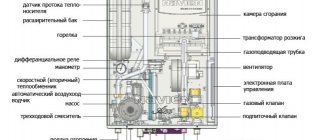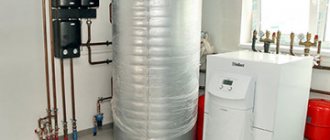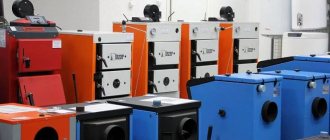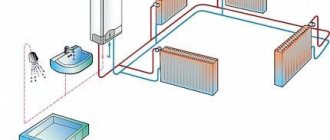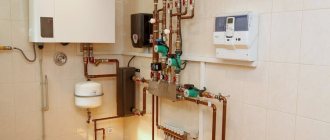An air conditioner helps make working indoors more comfortable, but only under one condition - if the device is selected correctly. There are many characteristics to consider, one of the leading ones is the power of the air conditioner. This parameter affects how efficiently the device will work, as well as how the electricity bill will change.
Air conditioner power for home Source www.stroysmi.ru
How an air conditioner works - device design
It is a well-known fact: air conditioners cool the air in a room. To understand how they do this, you will need minimal knowledge of how they work. The air conditioner consists of two main units - an internal one, which is located inside a room or office, and an external one, which is located outside.
The “heart” of the air conditioner is freon (refrigerant). This is a substance that has a high heat capacity, and it is with its help that the air is cooled to the desired temperature. Freon circulates through a closed system between the outdoor and indoor units. In the outdoor unit it is cooled by a fan, in the indoor unit the refrigerant itself cools the air.
Important! The refrigerant circulates in a closed circuit and should not enter the external environment. If this happens, the air conditioner's performance will decrease.
Checking for refrigerant leaks Source metropha.com
The air from the room is also a closed system. The air conditioner cools a certain volume of air to a given temperature and releases it to the external environment. Maximum efficiency is achieved when the windows and doors in the room are closed - then the volume of circulating air is constant.
When the air cools, excess moisture condenses from it - it is this that drips from the outdoor unit onto the street (you can put a special container for it and empty it regularly). An unpleasant side effect of air conditioning is associated with this - the air becomes dry over time. Condensation also creates an environment for bacteria to multiply. To combat negative phenomena, the room must be ventilated daily, and the air conditioner itself must be cleaned regularly (the frequency is indicated in the instructions).
Power calculation using additional parameters
Under certain circumstances, the required refrigeration capacity obtained in a typical calculation must be adjusted to take into account certain circumstances.
Taking into account the flow of fresh air from a slightly open window
If the user cannot imagine his existence without fresh air and plans to constantly ventilate the room while the air conditioner is operating, he should increase the Q1 value by 30% when calculating the refrigeration capacity.
You should not think that an air conditioner designed taking into account this amendment can be operated with the windows wide open - a household appliance, even the most powerful one, will not last long in such conditions.
It is understood that the window will be only slightly open (metal-plastic windows - in ventilation mode). Even better is to equip the room with a supply valve, the performance of which can be precisely controlled.
Guaranteed 18 – 20C
The given formula for calculating Q1 is aimed at ensuring a 10-degree difference between the temperatures outside and inside the room. It is this difference that is believed to provide sufficient comfort and at the same time be safe: entering a room from the street, a person does not risk catching a cold.
But some users, even in 40 degree heat, would like to have 18 - 20 degrees in the room. Then, when calculating, they should increase Q1 by 20% - 30%.
Top floor
In apartments on the upper floors, the area of the enclosing structures through which outside heat penetrates into the room is increased - a roof is added.
Moreover, thanks to its dark color, it basks in the sun quite strongly.
Therefore, residents of such apartments should increase the Q1 value by 10% - 20%.
Types and types of air conditioners
Selecting an air conditioner for a home, office or industrial enterprise begins with choosing the appropriate type of device. This is important to achieve the desired temperature and extend the life of the device. Main types of air conditioners:
- Wall-mounted split systems – have two blocks and are highly reliable;
- Multi-split systems - several indoor units are combined into a common system, several rooms are cooled at once;
Home multi-split system Source gaudisp.ru
- Mobile air conditioners – not fixed, can be carried;
- Window air conditioners are mounted on the window.
The listed systems relate to household air conditioners - they can be used at home or in a small office. For large premises, other types of air conditioners are used; they are called industrial and commercial.
Varieties of design
Air conditioner indoor unit
According to their design, there are two types of air conditioners - monoblock and consisting of two blocks. The two-block version is also called a split system.
Monoblock devices
A monoblock air conditioner looks like a single body, inside which all the components necessary for the operation of the equipment are located. These include a compressor, a filter for cleaning the air coming from outside, a fan, an evaporator and a condenser. The device controls are located on the monoblock body.
Floor standing monoblock
Monoblocks differ:
- window (built directly into the window opening)
- floor-mounted (placed near the window on the floor, connected with corrugated pipes to channels embedded in the window, or pipes are simply led out into the street through an open sash)
Floor-standing models are also called mobile - they can be easily disconnected from the channels and installed in a new location. Condensation from such monoblocks must be removed manually.
Monoblock air conditioners are inexpensive and easy to install - you can install the equipment yourself. At the same time, the demand for such equipment is steadily falling - it has low productivity and is noticeably noisy during operation.
Two-unit devices
Air conditioner external unit
The split system consists of two units: the external one (with a condenser and compressor) is mounted outside the building on the wall, and the internal one (with the evaporator) is placed indoors. The blocks are connected by a line designed for refrigerant circulation.
Air conditioners of this type include a multi-split system, consisting of an external unit of increased power and several internal ones, which can be installed in different rooms.
- Wall-mounted. The indoor unit is mounted on the wall, on the outside of which the outer part of the two-block air conditioner is mounted
- Floor-ceiling. If the glazing occupies a significant area of the wall, an internal block is used, which can be mounted near the wall on the ceiling or installed on the floor
- Cassette. The unit is designed for hidden installation in a suspended ceiling. Such models are more suitable for large areas in public buildings
- Duct. Indoor units are also mounted in a suspended ceiling. Such systems are usually installed at industrial, commercial and sports facilities with large areas
The advantages of split systems include wide functionality and economical energy consumption. Thanks to the low noise level, acoustic comfort in the apartment will be ensured even at night, when extraneous sounds are especially audible and can interfere with sleep. It is worth noting the rich set of equipment functions and the convenience of remote control.
The disadvantage of such climate control equipment is the high price, as well as the need to contact specialists for installation and maintenance of the air conditioning system. Before purchasing a split system, you need to make sure that local authorities do not prohibit the installation of external air conditioner units on the facade of the house.
Veranda attached to the house - expanding the living space: projects, tips on how to create it yourself (200 original photo ideas)
Air conditioner power: what it is and what it affects
An air conditioner has two powers - cooling power and power consumption. Both are measured in watts (W) and are listed in the device's specifications, but there are major differences between them.
Cooling power is a measure of the intensity with which the device cools the room. It can be indicated in W or other units - BTU (BTU). These are British thermal units, which also reflect the efficiency of the air conditioner.
Power consumption or electrical power is the amount of energy required to operate a device. It is measured in W, and is always less than the cooling power. Power consumption affects the electricity bill, but not the operating efficiency.
To calculate the power of the air conditioner and electricity consumption, a separate parameter is used - the efficiency indicator. This is the ratio of cooling power to power consumption. It is denoted by the abbreviation ERR, or indicated in BTU, where 1BTU is conventionally equivalent to 0.3W of power consumption.
It is important to understand the parameters of the air conditioner Source irp-cdn.multiscreensite.com
Energy Saving
The user asks a logical question about how to save energy: what can I do to pay less?
Everything will depend on various factors. On average, split systems with a power of two to three and a half kilowatts consume from half to one and a half kilowatts per hour.
Before installing an air conditioner, it is important to analyze the following parameters:
- what is the power consumption of the device, is the outlet designed for these indicators;
- what load will the electrical wiring withstand;
- parameters of meter safety plugs.
To avoid wasting money, you should choose the right device. There is a significant difference in the energy consumption of household, semi-industrial and industrial air conditioners. In addition to connection difficulties, industrial and semi-industrial air conditioners will consume several hundred kilowatts per month. While ordinary household air conditioners can cope with their responsibilities.
How to calculate power depending on the area of the room
The easiest way to select an air conditioner based on the area of the room is to pay attention to the parameters specified by the manufacturer. Typically this information is in the form of numbers - 7, 9 or 12 kBTU. This number is necessarily contained in the model name. It’s quite easy to navigate them:
- 07 – for a small room, no more than 20 sq.m;
- 09 – for rooms from 20 to 26 sq.m;
- 12 – for rooms up to 35 sq.m.
More power is usually not required for domestic premises. To choose the right device, you need to know the area of the room (you don’t have to remember it by heart, just read it in the technical data sheet at home) and compare it with the number indicated on the packaging.
Some companies use not only the listed numbers, but also intermediate values - 05, 10, 13, etc. This creates a wide variety of air conditioners and the ability to choose a device specifically for your needs, but it complicates the calculations. For this case, the general formula is suitable:
1 unit = 3 sq.m
The larger the area, the more powerful the air conditioner is needed Source zelclimat.ru
This is a simplified calculation, but it will help you avoid confusion when choosing a technique.
Some manufacturers (for example, Mitsubishi) indicate on the packaging the recommended room area in square meters, and calculating the air conditioner by room area is no longer necessary.
To convert from one unit to another, the formula is used:
1 kBTU = 293W
It refers to the cooling intensity, not the electricity consumed.
How does ceiling height affect
The previous section discussed only the area of the room, but residential buildings can have completely different ceiling heights. This affects the volume of air that the air conditioner will work with. Required power:
- With ceiling heights from 2.5 to 3 m – 100 W/sq.m;
- 3-3.5m – 120W/sq.m required;
- At 3.5-4m – 140W/sq.m.
Further, this rule remains the same - every 0.5 m of ceiling height requires an additional 20 W of air conditioner cooling power per square meter. If the power of the device is indicated in units, then it must first be converted to W. Manufacturers' recommendations usually apply to rooms with a ceiling height of 2.5-3 m.
A high ceiling requires a more powerful air conditioner Source 2.bp.blogspot.com
Heat sources
The air conditioner parameters are indicated for a room in which the air will not be heated additionally. Additional sources of heat in an enclosed space are people, animals and household appliances in it.
In fact, each of these objects emits a different amount of heat - a person can actively move or sleep, the most active air heater is a constantly turned on TV. But for simplicity, the calculations use the same value - 300W for each person, animal and household appliance.
Children are taken into account on the same basis as adults - they move a lot and exchange heat more intensely with the environment. If the number of people in the room is constantly changing, the maximum parameter is taken into account.
Of the animals, only warm-blooded ones are taken into account; for cats, small dogs and rodents, you can “make a discount” and count 100 W per animal. Pets in terrariums and aquariums do not have a significant impact on the temperature of the house, but you need to take into account the equipment that provides them with air and the optimal temperature. Plants are not taken into account when calculating the air conditioner.
People are also sources of heat Source mtdata.ru
See also: Catalog of companies that specialize in ventilation, air conditioning and lighting
Calculation examples
When calculating the power of the air conditioner based on the area of the room, you need to remember that all results will be approximate. There are many factors that are usually not taken into account - the thickness of the walls and finishing features, open windows or doors, the sudden arrival of guests who are a source of heat, etc.
Example No. 1
As an example, let’s take a room with an area of 24 sq.m. with a ceiling height of 2.5 m, in which 2 people and a cat live, 2 laptops are turned on during the daytime. The calculations look like this:
- With such a ceiling height, 100W of cooling energy per sq.m. is required, i.e. 2,400W for the entire room;
- People, equipment and cats each require another 300W of additional power, i.e. another 1,500W;
- The required power is 3,900 W, i.e. approximately 13kBTU.
At night, when the equipment is turned off and people are sleeping, the power of the device may be excessive (the dangers of this will be discussed below).
Example No. 2
Another example of calculating an air conditioner by area is for a small room with an area of 12 square meters, but with a ceiling height of 3.5 m. A man and a dog live in a room; guests come every weekend - 3-5 people.
Man and dog – the warmth of friendship is quite palpable Source www.rmim.com.tw
The calculations look like this:
- 140W is required per 1 sq.m (based on the height of the ceilings), i.e. 1 680W;
- A person and a dog each require 300W, i.e. 600W extra;
- Guests also require 300W, i.e. 900-1,500W when they arrive;
- The total power is 2,280W (about 8 units) for the owner or 3,180-3,780W (about 10-12 units) including guests.
Whether it is necessary to take into account people who are not in the premises all the time, but come quite regularly, is decided only by the owner of the premises. Manufacturers advise buying equipment with a reserve, since it is easier to cope with excess power than with its lack.
The location of the air conditioner also affects efficiency Source streetclimate.ru
Rating
Listed below are popular models of split systems that have already proven themselves well among buyers.
Ballu BSVP-07HN1
Designed for 21 square meters, it has proven itself among buyers. It is distinguished by its low price, low electricity consumption (class A), and also fairly compact dimensions. A split can work not only for cooling, but also to heat an apartment in the off-season, that is, when the outside air temperature is down to -7. Useful modes include dehumidification, self-diagnosis, ventilation, night, and timer. With a low price tag, the manufacturer equipped the device with saving settings (they will not be lost when the power is turned off), the ability to direct the flow, a motion sensor, a system that prevents the formation of ice, and a deodorizing filter. Power – 2.2 kW. Price – from 13,500 rubles. (2 store).
Daikin FTXB20C / RXB20C
An inverter model with 21 square meters from a brand that is considered one of the best in the segment. The device is not budget, but this is explained by the name and inverter motor. The system is quite compact and has a beautiful appearance. The noise level is very low - 21 dB. Functions include dehumidification, self-diagnosis, anti-ice system, timer, heating, saving settings in case of failure, flow control. Unlike many competitors, it can be turned on for heating at -15 degrees. As a rule, the lower threshold of most devices is 0. Another interesting point is that there are very few inverter sevens on the market. As a rule, they are produced starting from a capacity of 27 square meters. Thus, this model has practically no competitors. Price – from 39,200 rubles. (2nd store - Russia, Belarus, UA, Kazakhstan, Kyrgyzstan, 3rd store).
Toshiba RAS-09U2KHS-EE / RAS-09U2AHS-EE
By modern standards, an inexpensive 27 square model from a popular and high-quality brand from Japan. Electricity consumption – 2.6 kW, low noise level – 26 dB. Among the modes are self-diagnosis, prevention of ice formation, night mode, and the ability to select the air direction. Can be used for heating down to -7 degrees. The system does not have a display, but all settings and parameters are displayed on the remote control. Price – from 27,000 rubles. (2 stores - Russia, Belarus, UA, Kazakhstan, Kyrgyzstan).
Panasonic CS/CU-BE25TKE
Inverter air conditioner for 27 square meters and consumption of 2.5 kW. Received all modern functions - timer, adjustment of air flow direction, anti-ice systems, restart with specified parameters after a failure, self-diagnosis. Optionally, you can buy a module for control via Wi-Fi. That is, using this control unit you can turn on cooling or heating remotely from your smartphone. The system operates for heating at -15 degrees. Noise – 20 dB. The purchase price is from 33.5 thousand rubles. (2 stores - Russia, Belarus, UA, Kazakhstan, Kyrgyzstan).
LG P12SP
Despite the inverter motor, this model has a very affordable price tag, which may be a reason to buy it. Designed for an area of up to 36 square meters. Noise level - 19 dB. Electricity consumption – 3.6 kW. The system operates for heating down to -5 degrees. A plus is the double cleaning filter. It is possible to direct the air flow and set a timer. It is equipped with a motion sensor, that is, it will start working if a person enters the room. Price – from 35,900 rubles. (2 stores - Russia, Belarus, UA, Kazakhstan, Kyrgyzstan).
Video description
About calculating the power of an air conditioner in the video:
How to make your task easier - table
Before choosing an air conditioner based on the area of the room, you can create a table of parameters that will help you not miss anything. The data in it is indicated without taking into account additional heat sources.
| 2.5m (100W) | 3m (120W) | 3.5 (140W) | 4m (160W) | |
| 8sq.m | 800W (3kBTU) | 960W (4kBTU) | 1 120W (4kBTU) | 1,200W (4kBTU) |
| 10sq.m | 1,000W (4kBTU) | 1,200W (4kBTU) | 1,400W (5kBTU) | 1,600W (6kBTU) |
| 12sq.m | 1,200W (4kBTU) | 1,440W (5kBTU) | 1,680W (6kBTU) | 1,920W (7kBTU) |
| 16sq.m | 1,600W (5kBTU) | 1,920W (6kBTU) | 2 240W (8kBTU) | 2,560W (9kBTU) |
| 20sq.m | 2,000W (7kBTU) | 2,400W (8kBTU) | 2,800W (10kBTU) | 3,200W (11kBTU) |
| 24sq.m | 2,400W (8kBTU) | 2,880W (10kBTU) | 3 360W (11kBTU) | 3,840W (13kBTU) |
| 30sq.m | 3,000W (10kBTU) | 3,600W (12kBTU) | 4,200W (14kBTU) | 4,800W (16kBTU) |
The advantage of this table is that you can find the desired value in it, knowing the area and height of the ceilings. The disadvantage is that it does not take into account people, animals and household appliances in the room. In order not to miss such important details when calculating the power of an air conditioner, a power calculator will come in handy. Its online versions are available on the manufacturers' websites - you need to enter the initial data in a special form, and the program will automatically calculate the required power in the units required. This is the most convenient and easiest way to determine which device the customer needs.
When the power has been selected, it’s time to start installation. Source klimat-24.ru
Video description
This video shows how to measure the current consumption and power of an air conditioner:
Lack of power
A weak split system will not be able to fully perform its job or will work at its maximum capacity. As a result, it will break faster, or you will have to keep it on all the time, which again leads to breakdowns. If the air conditioner fails to cope even with constant operation, the room will be hot, and only under the device itself a strong air flow will blow.
If there is not enough power, the air conditioner cannot cope Source i.ytimg.com
Special design conditions
There are a number of factors that additionally influence the microclimate and, accordingly, the required cooling power. In order to subsequently avoid getting into a situation where the installed unit works without turning off around the clock, you need to take into account the following conditions:
- The room is located on the top floor of the building.
- Non-standard windows with a large glazing area or part of a translucent roof.
- There are always a large number of people in the room (office).
- Frequent ventilation or high infiltration of outside air into the building.
- A large number of household or office equipment.
In this case, it is recommended to increase the calculated cooling capacity of the air conditioner by applying a coefficient from 1.2 to 1.5.
